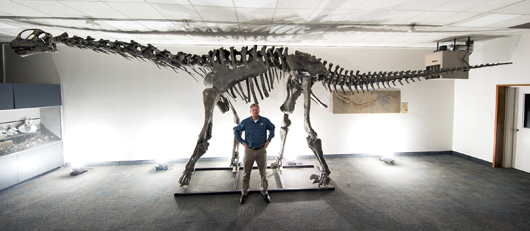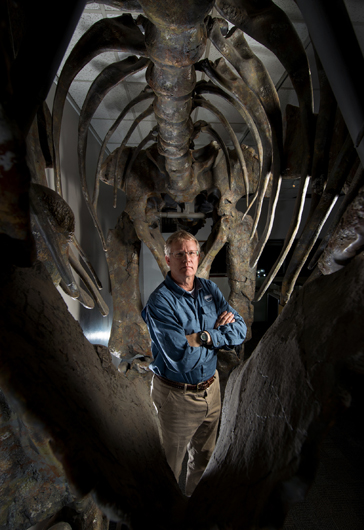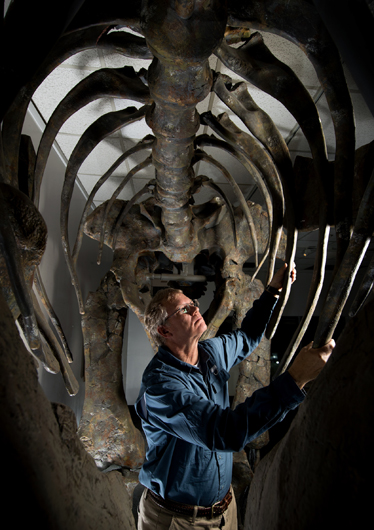Moabosaurus of the Aptian of North America
Moabosaurus utahensis – Adding to the Early Cretaceous Dinosaur Fauna of North America
Researchers from Brigham Young University writing in the University of Michigan’s Contributions from the Museum of Palaeontology, have published details of Utah’s latest dinosaur discovery, an Early Cretaceous Sauropod that roamed the western United States some 125 million-years-ago. At a little under ten metres in length, Moabosaurus may not be the largest member of the Sauropodomorpha, but it remains a very significant dinosaur discovery nonetheless.
Moabosaurus utahensis
Compared to the earlier Morrison Formation fauna, not that much is known about the dinosaurs that roamed this part of the United States during the (Aptian faunal stage). Moabosaurus, shared its lush, flood plain world, that was prone to prolonged droughts with dinosaurs such as Cedarosaurus (sauropod) and Gastonia (armoured dinosaur), as well as a variety of theropods.
The Mounted Skeleton (Composite) Ready for Display
Picture credit: Jaren Wilkey/Brigham Young University
Observant readers will note that the skull on this composite mount is actually a cast of a Camarasaurus skull.
The picture above shows Brigham Young University professor and lead author of the scientific paper, Brooks Britt, posing in front of the mounted exhibit of Moabosaurus (M. utahensis). The fossils assigned to this new dinosaur genus, were all excavated from the Dalton Wells Quarry, some twelve miles north-west of the town of Moab (Utah).
Moabosaurus Fossil Bones
Around 5,500 fragmentary bones were found entombed in the mudstone, the majority of which represents Moabosaurus, although the fossils were badly damaged, in part due to being trampled by other dinosaurs and from insect damage (probably beetle larvae), that fed on the bones when they had been initially buried.
Based on braincase sampling and other fossil finds, the researchers have suggested that at least eighteen individuals are represented. The bones were also transported a short distance by water and buried in sediments reworked from the much older Morrison Formation.
For models and replicas of Morrison Formation and Cedar Mountain Formation dinosaurs: PNSO Age of Dinosaurs Models.
Dalton Wells Quarry – Yellow Cat Member of the Cedar Mountain Formation
The preparation of a shattered femur which measures around 1.3 metres in length indicates that this dinosaur grew to about 9.75 metres in size. Everything Dinosaur team members estimate that this herbivore might have weighed as much as an African elephant. Palaeontologists tend to agree that, based on the current evidence, there was a substantial decline of sauropod diversity in North America from the Late Jurassic and into the Early Cretaceous.
As to where Moabosaurus fits into the sauropod family tree, that remains open to debate. The researchers, which included Brigham Young University Museum of Palaeontology Curator Rod Scheetz and biology professor Michael Whiting plus a co-worker from Auburn University (Alabama), carried out four different taxonomic assessments using three different data sets. Moabosaurus has been identified as a neosauropod, two studies indicate that this dinosaur has affinities with the Macronaria, as such, it is regarded as a basal titanosauriform.
Sorting the Taxonomy
It has been proposed that Moabosaurus was closely related to Turiasaurus (T. riodevensis) of the Early Cretaceous of Spain and Tendaguria (T. tanzaniensis) from the Late Jurassic of Tanzania. Further phylogenetic studies will help to define the exact position of Moabosaurus in the sauropod family tree.
A View of the Mounted Exhibit of Moabosaurus
Picture credit: Jaren Wilkey/Brigham Young University
If Moabosaurus is closely related to Turiasaurus and Tendaguria then it suggests that land bridges may have existed between Gondwana and Laurasia to permit the mixing of faunas for longer into the Cretaceous than previously thought. Analysis of zircon crystals, remnants of volcanic activity, indicate that Moabosaurus lived during the very earliest part of the Aptian faunal stage. The phylogeny of Moabosaurus remains contentious. In the scientific paper, “Moabosaurus utahensis – A New Sauropod from the Early Cretaceous of North America”, there is some discussion as to whether Nemegtosaurus and Quaesitosaurus (both from the Late Cretaceous of Mongolia), are sister taxa.
Examining the Sturdy Ribs of Moabosaurus
Picture credit: Jaren Wilkey/Brigham Young University
This Moabosaurus Perished in a Severe Drought
A previous study indicated that a large number of Moabosaurus and other dinosaurs died in a severe drought. Survivors trampled their fallen companions’ bodies, smashing and crushing their bones. After the drought ended, streams eroded the land, and transported the bones a short distance, where they were again trampled. Meanwhile, insects in the soils fed on the bones, leaving behind tell-tale burrow marks.
Professor Britt stated:
“We’re lucky to get anything out of this site. Most bones we find are fragmentary, so only a small percentage of them are usable and that’s why it took so long to get this animal put together. We had to collect huge numbers of bones in order to get enough that were complete.”
Visit the Everything Dinosaur website: Everything Dinosaur.




